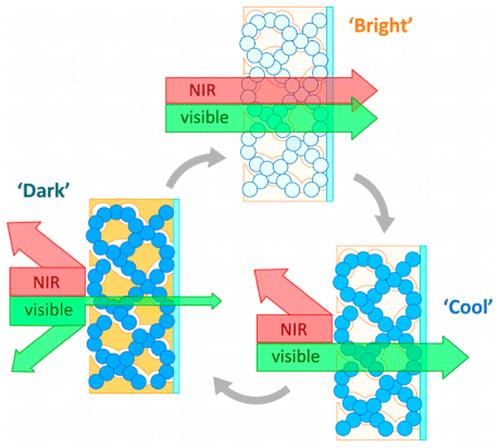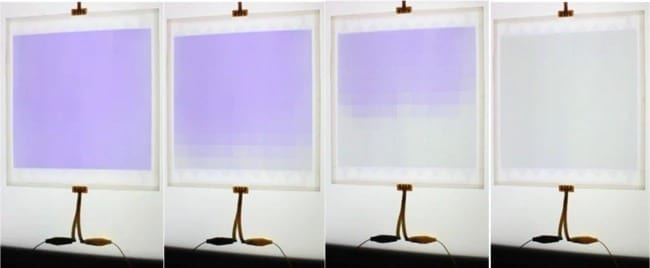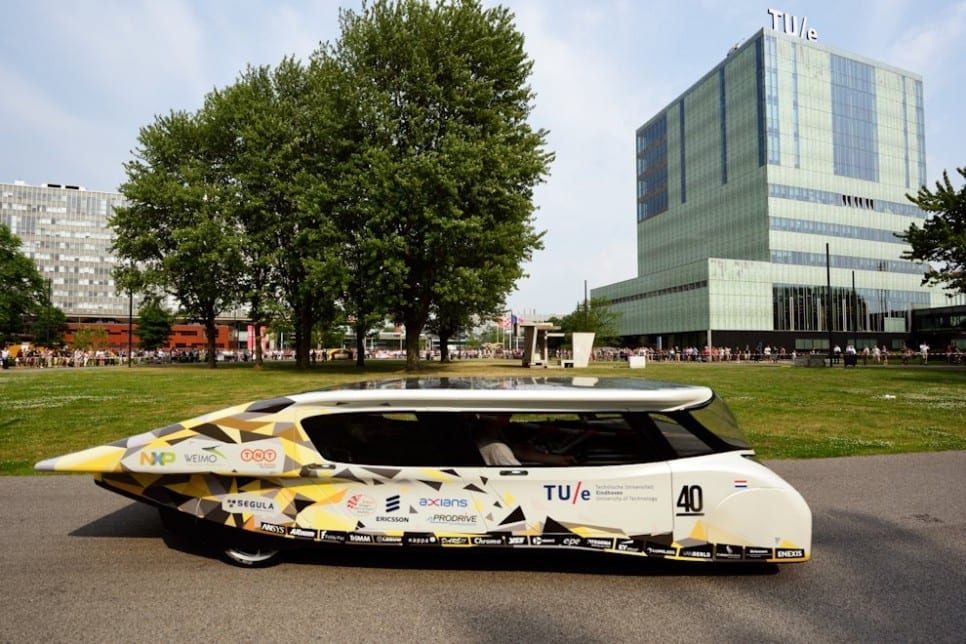
CREDIT
Nano Letters
Researchers in the Cockrell School of Engineering at The University of Texas at Austin are one step closer to delivering smart windows with a new level of energy efficiency, engineering materials that allow windows to reveal light without transferring heat and, conversely, to block light while allowing heat transmission, as described in two new research papers.
By allowing indoor occupants to more precisely control the energy and sunlight passing through a window, the new materials could significantly reduce costs for heating and cooling buildings.
In 2013, chemical engineering professor Delia Milliron and her team became the first to develop dual-band electrochromic materials that blend two materials with distinct optical properties for selective control of visible and heat-producing near-infrared light (NIR). In a 2013 issue of Nature, Milliron’s research group demonstrated how, using a small jolt of electricity, a nanocrystal material could be switched back and forth, enabling independent control of light and energy.
The team now has engineered two new advancements in electrochromic materials — a highly selective cool mode and a warm mode — not thought possible several years ago.
The cool mode material is a major step toward a commercialized product because it enables control of 90 percent of NIR and 80 percent of the visible light from the sun and takes only minutes to switch between modes. The previously reported material could require hours.
To achieve this high performance, Milliron and a team, including Cockrell School postdoctoral researcher Jongwook Kim and collaborator Brett Helms of the Lawrence Berkeley National Lab, developed a new nanostructured architecture for electrochromic materials that allows for a cool mode to block near-infrared light while allowing the visible light to shine through. This could help reduce energy costs for cooling buildings and homes during the summer. The researchers reported the new architecture in Nano Letters on July 20.
“We believe our new architected nanocomposite could be seen as a model material, establishing the ideal design for a dual-band electrochromic material,” Milliron said. “This material could be ideal for application as a smart electrochromic window for buildings.”
In the paper, the team demonstrates how the new material can strongly and selectively modulate visible light and NIR by applying a small voltage.
To optimize the performance of electrochromics for practical use, the team organized the two components of the composite material to create a porous interpenetrating network. The framework architecture provides channels for transport of electronic and ionic change. This organization enables substantially faster switching between modes.
The researchers are now working to produce a similarly structured nanocomposite material by simple methods, suitable for low-cost manufacturing.
Read more: Smarter window materials can control light and energy
The Latest on: Smart Windows
[google_news title=”” keyword=”Smart Windows” num_posts=”10″ blurb_length=”0″ show_thumb=”left”]
via Google News
The Latest on: Smart Windows
- Buy Windows 11 Pro for just $30on April 28, 2024 at 4:00 am
Windows 11 Pro brings an improved user interface and heightened customization to the table. You're getting more advanced security features with this software, like biometrics login, TPM 2.0 Smart App ...
- Mask-inspired perovskite smart windows enhance weather resistance and energy efficiencyon April 25, 2024 at 6:36 am
Thermochromic perovskite is a new color switch material used in energy-saving smart windows. Despite its potential for energy savings, thermochromic perovskite suffers from poor weather resistance, ...
- The spam came from inside the house: How a smart TV can choke a Windows PCon April 23, 2024 at 3:15 pm
The modern "smart" TV asks a lot of us. In exchange for connecting you to a few streaming services you use, a TV will collect data, show ads, and serve as another vector for bad actors. In a few ...
- How potatoes, corn and beans led to breakthrough in smart windows technologyon April 23, 2024 at 7:10 am
Smart windows are an exciting technology, capable of blocking out or letting in more light as needed, potentially reducing energy costs of large buildings by making them more efficient. This ...
- Boost your PC’s performance with Windows 11 Pro, now under $30on April 23, 2024 at 3:22 am
Update your PC's performance when you get lifetime access to Windows 11 Pro for just $29.97 through April 30 at 11:59 PM Pacific.
- Is your PC having trouble? Your smart TV might be to blameon April 22, 2024 at 3:15 pm
It turns out your TV can actually mess up your computer — at least if you’re using a Hisense TV and Windows. Priscilla Snow, a sound designer and composer for games, wrote on Cohost that they’d been ...
- Smart Windows Market The Unexplored Realm Revolutionizing Deep Understanding through Observational Researchon April 21, 2024 at 5:10 pm
Report Ocean recently added a research report on “Smart Windows Market”. The report includes an extensive analysis of the market’s characteristics, COVID-19 impact, size and ...
- 2025 Smart #5 EV: This Is What The Production SUV Will Look Likeon April 20, 2024 at 12:57 pm
From pint-sized to porky – is it a smart play to aim so big? The Smart #5 enters a crowded electric SUV market, facing established players ...
- How Using Smart Tech at Home Can Lower Your Insurance Billson April 18, 2024 at 7:30 am
Since smart tech can work to prevent the kind of costly events that result in insurance claims, it makes sense that there’s an emerging trend of insurance companies offering discounts for specific ...
- More Windows PCs are now getting the free upgrade to Windows 11on April 16, 2024 at 3:38 am
If you have a Windows 10 computer, Microsoft will offer you a free upgrade to Windows 11. Provided the hardware of the Windows 10 computer is compatible, otherwise Windows 11 will refuse the ...
via Bing News










